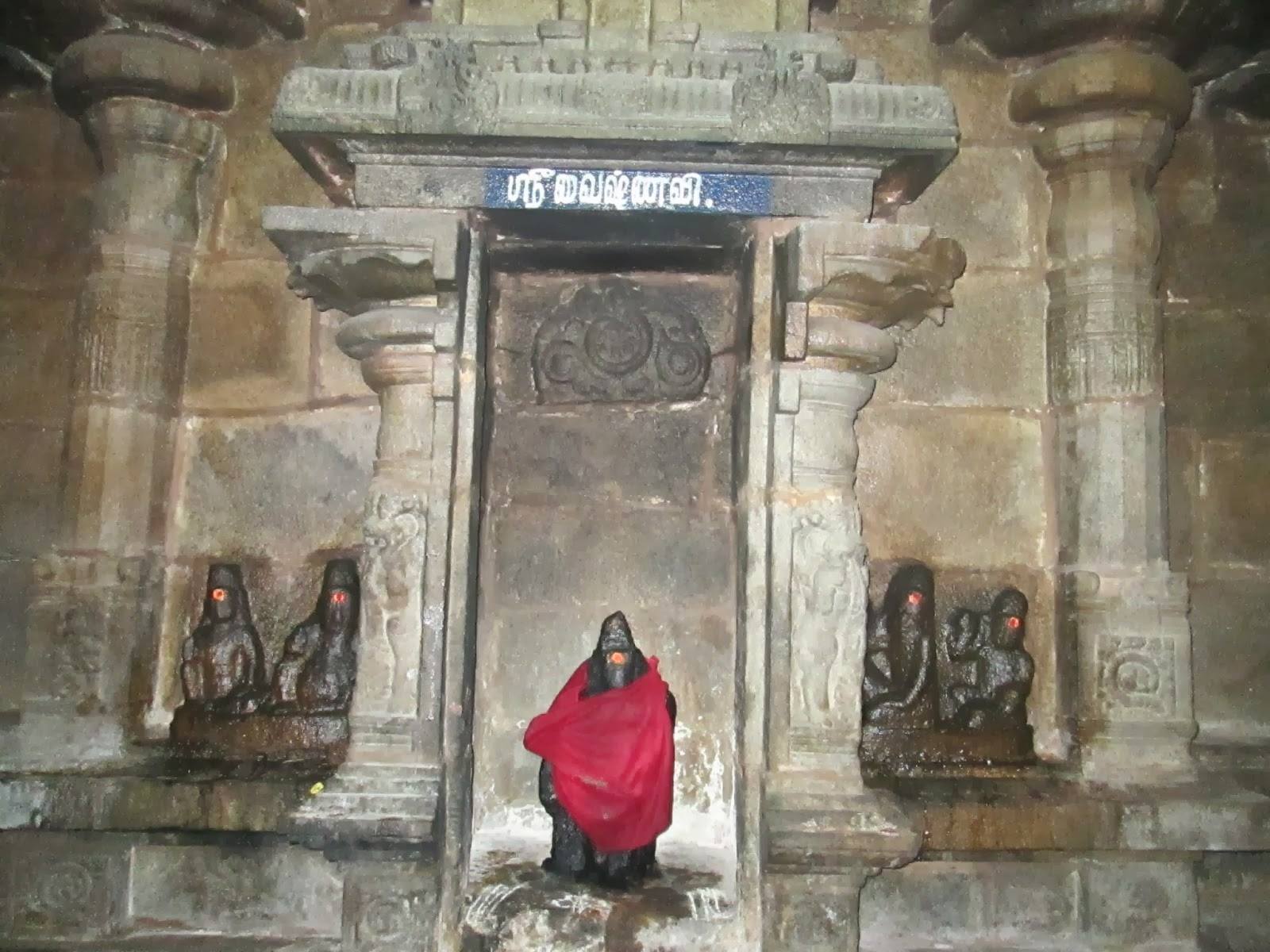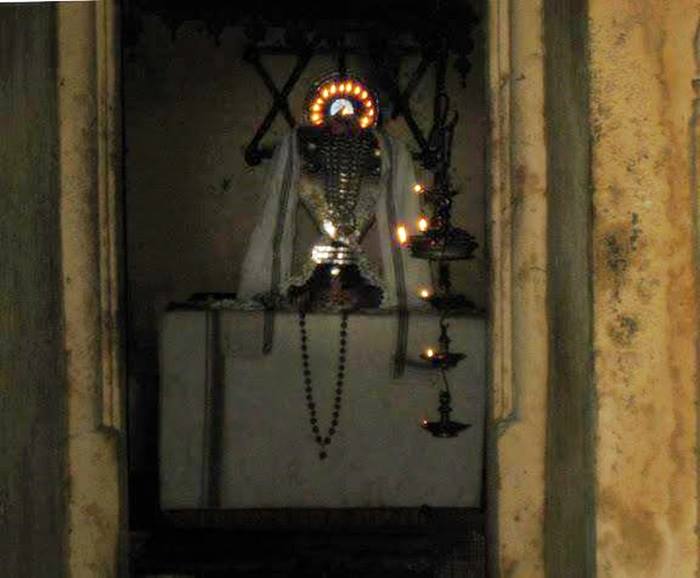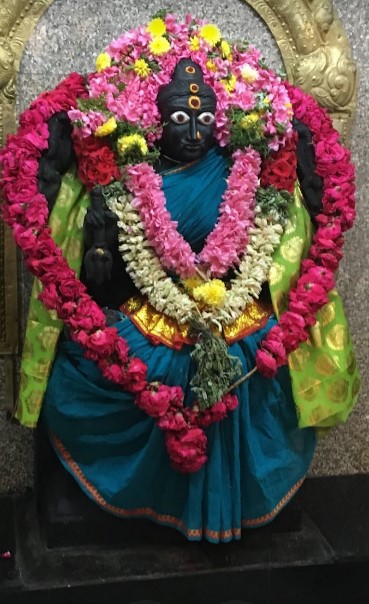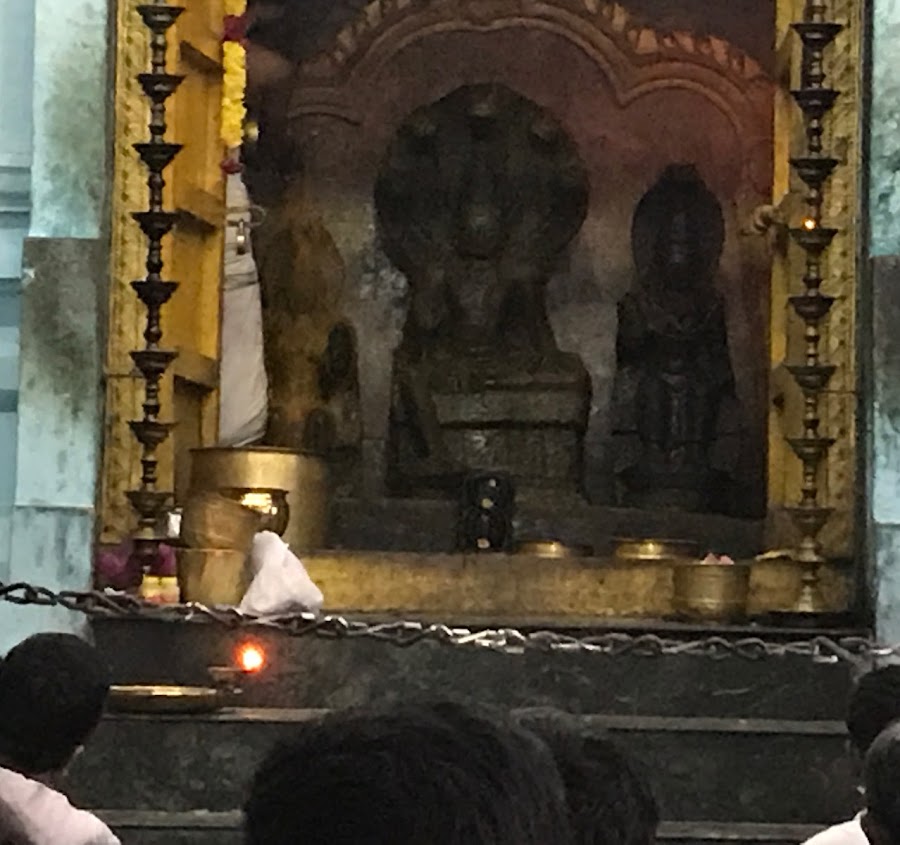






The temple is one of the Navagraha sthalas of Tamil Nadu and is known to be the temple where Bhagwan Shiva relieved Rahu from his curses. Rahu is a shadow planet and has no physical existence. A special feature of this temple is that Rahu is seen with human head, whereas in other temples Rahu is seen with serpent head Kings of snakes Adisesha, Thakshagan and Karkotagan are also worshipped here to seek blessings.
The temple has its presiding deity Bhagwan Shiva as Bhagwan Naganathar and Goddess Parvati as Piraisoodi Amman. Rahu is worhsiped in a separate shrine here along with his consorts Nagavaalli and Nagakanni. The temple also has shrines of many other deities. The Vinayaka shrine in the temple is known to be installed by saint Sadasiva. The temple’s holy tank, Sula Theertham is said to have powers of disintegrating the sins of anyone who take a dip in it.
This temple is located in a small village Tirunageswaram of kumbakonam, Thanjavur district Tamil Nadu. It is built on the banks of river Cauvery. Tirunageswaram is one of the many temple towns in Tamil Nadu which is named after the grooves, clusters or forests dominated by a particular variety of a tree or shrub and the same variety of tree or shrub sheltering the presiding deity. The region is believed to have been covered with Chamapaka forest and hence called Chamapakavanam
The Abhishekam of the image of Rahu during Rahukaalam with milk turning to blue colour in this temple is considered to be a miracle.
Being a Navagraha Sthala and a Paadal Petra Sthalam, this temple holds great religious importance in the Hindu philosophy. The temple is known to be the place where rahu was relieved from his curses by the grace of Bhagwan Shiva as Naganathar. Many more sages and kings are said to have earned their relief by offering prayers at this temple.
Many serpents, including Adishesha, Takshaka and Karkotaka, worshipped Shiva at this place, leading to the name “Tirunageswaram”.
It is believed that the king of snakes, Adisesha did penance at this place, called Senbaranya Kshetram on account of the presence of large number of Senbaga trees. Shiva was pleased by the penance and appeared to him. Since Shiva gave a boon to the king of Serpents, he is called Naganathar.
A Goddess Girigujambal is believed to be worshipping Shiva here with goddesses Lakshmi, Saraswathi, Ganesha, Muruga, and Shasta. Maha Bhairava is still believed to be guarding and assisting the divine mother during her prayers. The Goddess is said to be Swayambu as she is present in the form of Meru. Hence, no abhishekam is performed for the image.
It is believed that people who are born with unfavourable position of Rahu as per their birth star, Rahu Dosha, face issues in marriage, family, career and business. To ease these hurdles, Pariharam of dosha has to be performed. It is believed that one suffering with Sarpa dosha or malefic effects of Rahu – Kethu can seek relief in a single day by offering prayers to Kudanthai in the morning, Thirunageshwaram Naganathar at the noon, Thirupampuram Pambureswarar in the evening and Nagoor Nageshwarar at night in this temple.
Rahu Bhagwan is believed to be the cause for one’s good position, business, status, winning over opposition, faithfulness, to travel overseas, and for mantra power. As per the ancient science of Astrology, Rahu is considered a shadow planet which means it has no real physical existence. Anyhow, its malefic influence is very powerful, and its presence is said to make the lives of natives burdensome. It is believed that the presence of Rahu in one’s horoscope signifies karma bondage coming down from their previous births. Puthira Dosham, Kalathra Dosham, Sarpa Dosham, mental disorders, communicable diseases, leprosy, delay in getting married, childlessness, troublesome married life, fall in grace are caused by Rahu Dosham.
This temple is open every day from 6:00 am to 12:45 pm. In the afternoon, the temple is open again from 4 pm until 8:30 pm.
The ritual of putting the lord to sleep, palliarai, is quite famous here. First, the idol of the goddess enters the chamber and is seated on a cradle. The lord’s idol is then taken around the first prakaram in a palanquin and brought to the chamber, where he is placed beside the goddess. Milk is then offered to the deities and given to the devotees.
The temple performs six daily pujas which comprise of four steps, abhisheka or the sacred bath, alangaram or decoration, neivedanam or offering of food and deepa aradhani or lighting of lamp. The six pujas and their timings are as follows
6:00 am Ushathkalam
9:00 am Kalashanti
1:00 pm Uchikalam
5:00 pm Sayarakshai
7:00 pm Irandamkalam
9:00 pm Ardhajamam
Apart from the above pujas, the ritual of Rahu Abhishekam is performed twice a day at 11:30 am and 5:30 pm.
This temple was built by Aditya chola 1 in the 10th century A.D. later on this temple was modified by the Nayak kings, they added many pillared halls to this temple. Govinda Dikshitar who was a minister of the Nayak rulers constructed the hall in the late 15th century.
The Ganapathy shrine at the east entrance was constructed by a great sage called sadasiva Brahmendra. He also placed the Ganpathi yantra, the proof pf which can be seen in the inscription on the temple.
This temple is categorized as Padal Petra Sthalam because of being mentioned in the Saivite canonical work Tevaram by Nyanmars of 7th century.
There are four entry towers with fort like walls which surround the outermost prakaram. Multi-tiered gopurams tower over the gateways, A high compound wall encloses the entire temple complex. Additionally, the third precinct or prahara houses a flower garden, on the Northern side. There is also a Ganapathy shrine, a Dwajasthambam, Nandikeshwara Hall, and Bali Peetam on the Eastern side. The Rahu shrine is located in the South-West corner.
The sthalapurnas describes that there were 12 ponds beautifully encircled this temple in olden days. Presently, only one pond Surya Theertham is evident at sight. Holy dip in this pond provides abundance of devoutness. King Chandravarman regained his original form after a holy dip in this pond. Few of the theerthams at this place –
Surya Theertham
Gouthama Theertham
Parasara Theertham
Indra Theertham
Bhrigu Theertham
Kanva Theertham
Vasishta Theertham
By Air: The nearest airport is Trichy airport at a distance of about 100 km.
By Rail: Thirunageswaram has its own railway station connected by passenger trains with Kumbakonam, Mayiladuthurai, Thanjavur and Trichy stations.
By Road: The Temple is on the Kumbakonam – Karaikal bus route at a distance of 6 km from Kumbakonam. Adequate bus facilities are available from Kumbakonam to the temple.
Quality Inn VIHA – Kumbakonam
Hotel green park – Kumbakonam
Sivas Residency – Thirunageswaram
The temple performs weekly rituals of Somavaram and Sukravaram and pradoshams fortnightly.
Monthly celebrations are:
Amavasi (new moon day)
Kiruthigai
Poornami (full moon day)
Sathurthi
Other yearly festivals are:
Brahmotsvam in November – December
Kandashasti in October – November
Navaratri in September – October
Vijayadashmi in August – September
Rahu Peyarchi is a festival celebrated in every one and half year when Rahu changes his planetary placement.
This is one of the most visited temples of south for pariharam of Rahu and Sarpa dosha.
One can witness a miracle that happens during the Rahukalam abhishekam when the milk poured on the murti of Rahu can be seen turning blue clearly with the naked eyes. So, this temple earns its place in the ‘must-visit’ list of devotees.
ಸ್ವಾಮಿ ಸೂರ್ಯೇಶ್ವರ ಸದಾಶಿವ ರುದ್ರದೇವ ಇಂದು ರಾತ್ರಿಯೊಳಗೆ ನನ್ನ ಕೈ ಕಾಲಿಗೆ ಶಕ್ತಿ ನೀಡಿದರೆ ನಿನ್ನಯ ದರ್ಶನ ಪಡೆದು ಮಣ್ಣಿನ ಬೊಂಬೆ ಹರಕೆ ಒಪ್ಪಿಸಿ, ರುದ್ರ ಹೋಮ ನೆರವೇರಿಸಿ ಯಕ್ಷಗಾನ ಸೇವೆ ಸಮರ್ಪಿಸುವೆ ತಂದೆ ಧರ್ಮಸ್ಥಳ ನಂಜುನಾಥನ ಮೇಲಾಣೆ.
